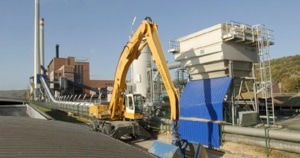Awirs (Belgium)
A brief introduction to the engineer who’s going to be our guide, to the firm he works for (Laborelec, a subsidiary society of Electrabel, which belongs to the French giant ‘Electricité de France’) and to the specificity of the Power Station in Les Awirs.
Who supplies the pellets? What about olive pits, used in the past?
Burning wood biomass only produces a quantity of CO2 that is equivalent to the quantity of CO2 that was absorbed via photosynthesis during the life of the trees used to produce the pellets. So burning biomass is a neutral operation from an ecological point of view.
Burning wood biomass only produces a quantity of CO2 that is equivalent to the quantity of CO2 that was absorbed via photosynthesis during the life of the trees used to produce the pellets. So burning biomass is a neutral operation from an ecological point of view.
A quick comparaison of the efficiency of different sources of green energy.
A few comments about the future of wood biomass. Is burning wood biomass sustainable?
A few comments about the future of wood biomass. Is burning wood biomass sustainable?
Videocasts 1-2-3
Gap-fill exercise
Fill in all the gaps, then press "Check" to check your answers. Use the "Hint" button to get a free letter if an answer is giving you trouble. Note that you will lose points if you ask for hints!
Videocasts 1-2-3
Multiple choice quiz
- 2005 in an important year for the power station in Les Awirs
- because thay started burning olive pits
- because they started burning wood
- because they started burning wood pellets
- In the Power Station in Les Awirs,
- they use wood pellets mixed with coal
- they use the energy developed in the burner only to produce electricity
- because they use the energy developed in the burner not only to produce electricity but also to provide heating to the local community
- In order to convert their coal Power Stations into a wood pellet power station, they have
- received subsides from the Walloon region
- received subsides from the European community
- not received any subsidies from anywhere
- Electricity produced with wood as source of energy is
- less expensive than electricity produced with coal
- clearly more expensive than electricity produced with coal
- about as expensive as electricity produced with coal
- At tha moment, the pellets used in Les Awirs come from
- Holland
- Local suppliers
- Canada
- The burning of biomass produces a certain quantity of CO2. That quantity
- is equivalent to the C02 produced by the transportation of the biomass
- is equivalent to the CO2 absorbed by the trees used to make the biomass during their whole lives
- negligable

